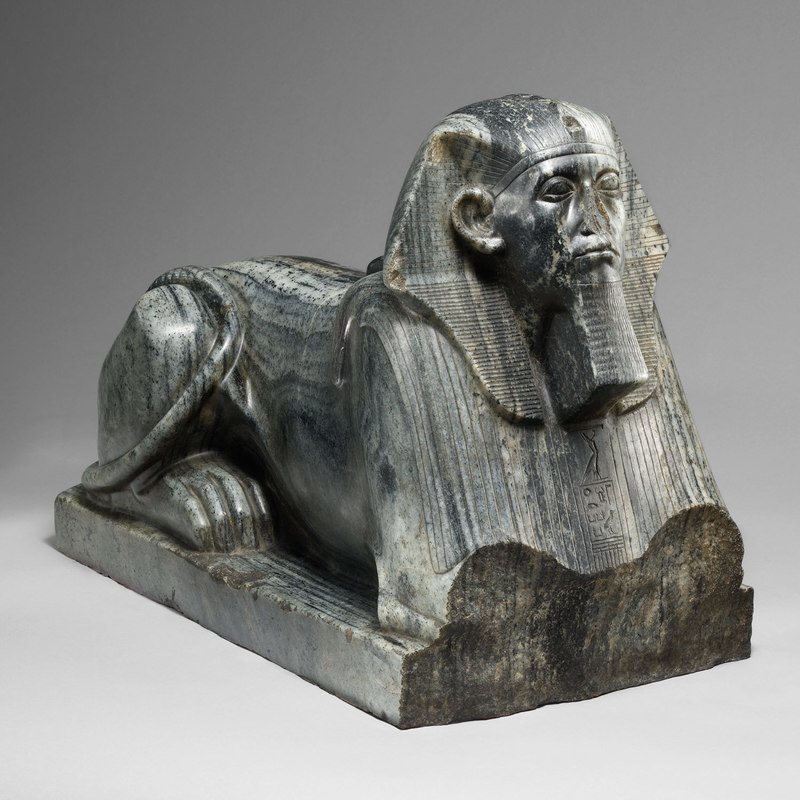Senwosret III as a Sphinx
Title
Senwosret III as a Sphinx
Date
Dynasty 12, ca 1878 BCE - 1840 BCE
Artist or Workshop
Unknown
Materials
Gneiss
Height of the work
Height: 42.5 cm
Provenience
This piece was bought in Cairo, Egypt in 1917 by Edward S. Harkness from Maurice Nahman.
Current Location
The MET. (Metropolitan Museum of Art)
Description and Significance
Description:
The sculpture titled Senwosret III as a Sphinx is quite imposing and formidable. The material used to make the sculpture is gneiss. The structure of the sculpture includes the head of a human, in this case the head of the Pharaoh Senwosret III combined with the body of a lion. The front legs of this sphinx are missing. The rear legs are present. The head and face of the sculpture include the pharaonic headdress (nemes), part of a serpent (Uraeus) and a beard. The face of this sculpture has a fatigued and somber look. The sculpture has a very smooth texture. Yet, the stone has a striated look to it. As part of the striated appearance, there are horizontal and vertical lines running the length of the sculpture and its base. The sculpture has inscriptions underneath the beard.
Significance:
This is a very important sculpture. This sphinx represents one of the great pharaohs of the 12th Dynasty of the Middle Kingdom. One of the most amazing aspects of this sculpture is its surface. The surface is simply majestic. There is an incredible level of precision in the carving. The multicolored gneiss stone looks stunning up close. The carving of the gneiss length wise complements the colors of the stone. They combine to create a sense of movement. A significant fact about the gneiss is that it came from Nubia, meaning that it came from outside of Egypt. That tells us that the Egyptians had access to their neighbors' resources. One of the most powerful aspects of the sphinx is its tail. The tail gives the sculpture a fearsome quality. I genuinely fear that the tail of the sphinx is going to move. There is a feeling of life in this sculpture. A part of that feeling of life in the sculpture is in the face of the sculpture. Whilst the faces of Old Kingdom pharaonic sculptures had a very imposing look, the Middle Kingdom faces become somewhat distressed and drained. This has to do with the worry that the pharaohs were experiencing at the time. The dawn of the reality of the pharaoh's responsibilities are show in their faces of the sculpture.
The sculpture titled Senwosret III as a Sphinx is quite imposing and formidable. The material used to make the sculpture is gneiss. The structure of the sculpture includes the head of a human, in this case the head of the Pharaoh Senwosret III combined with the body of a lion. The front legs of this sphinx are missing. The rear legs are present. The head and face of the sculpture include the pharaonic headdress (nemes), part of a serpent (Uraeus) and a beard. The face of this sculpture has a fatigued and somber look. The sculpture has a very smooth texture. Yet, the stone has a striated look to it. As part of the striated appearance, there are horizontal and vertical lines running the length of the sculpture and its base. The sculpture has inscriptions underneath the beard.
Significance:
This is a very important sculpture. This sphinx represents one of the great pharaohs of the 12th Dynasty of the Middle Kingdom. One of the most amazing aspects of this sculpture is its surface. The surface is simply majestic. There is an incredible level of precision in the carving. The multicolored gneiss stone looks stunning up close. The carving of the gneiss length wise complements the colors of the stone. They combine to create a sense of movement. A significant fact about the gneiss is that it came from Nubia, meaning that it came from outside of Egypt. That tells us that the Egyptians had access to their neighbors' resources. One of the most powerful aspects of the sphinx is its tail. The tail gives the sculpture a fearsome quality. I genuinely fear that the tail of the sphinx is going to move. There is a feeling of life in this sculpture. A part of that feeling of life in the sculpture is in the face of the sculpture. Whilst the faces of Old Kingdom pharaonic sculptures had a very imposing look, the Middle Kingdom faces become somewhat distressed and drained. This has to do with the worry that the pharaohs were experiencing at the time. The dawn of the reality of the pharaoh's responsibilities are show in their faces of the sculpture.
References
"The British Museum" Website:
http://www.britishmuseum.org/research/search_the_collection_database/term_details.aspx?bioId=25514
"The MET" Website:
http://www.metmuseum.org/art/collection/search/544186
Google Arts and Culture Website:
https://www.google.com/culturalinstitute/beta/asset/head-of-a-sphinx-of-senwosret-iii/9gHsiUAq-4V7Xg
Academic Article Found Online: Habachi, Labib. "The Gneiss Sphinx of Sesostris III: Counterpart and Provenance," The University of Chicago Press," Vol 19/20, 1984/1985, pp. 11-16
"Middle Kingdom of Egypt." Ancient History Encyclopedia. N.p., n.d. Web. 12 Mar. 2017.
http://www.britishmuseum.org/research/search_the_collection_database/term_details.aspx?bioId=25514
"The MET" Website:
http://www.metmuseum.org/art/collection/search/544186
Google Arts and Culture Website:
https://www.google.com/culturalinstitute/beta/asset/head-of-a-sphinx-of-senwosret-iii/9gHsiUAq-4V7Xg
Academic Article Found Online: Habachi, Labib. "The Gneiss Sphinx of Sesostris III: Counterpart and Provenance," The University of Chicago Press," Vol 19/20, 1984/1985, pp. 11-16
"Middle Kingdom of Egypt." Ancient History Encyclopedia. N.p., n.d. Web. 12 Mar. 2017.
Contributor
Sai Teja Surapaneni
Citation
Unknown, “Senwosret III as a Sphinx,” Digital Portrait "Basket" - ARTH488A "Ancient Mediterranean Portraiture", accessed June 6, 2025, http://classicalchopped.artinterp.org/omeka/items/show/11.
Item Relations
This item has no relations.

